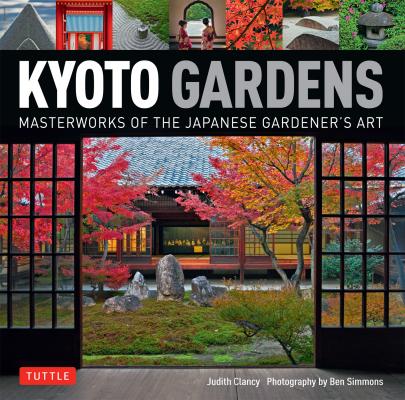Kyoto Gardens. Judith Clancy
Читать онлайн.| Название | Kyoto Gardens |
|---|---|
| Автор произведения | Judith Clancy |
| Жанр | Книги о Путешествиях |
| Серия | |
| Издательство | Книги о Путешествиях |
| Год выпуска | 0 |
| isbn | 9781462915033 |
The fleeting embace of hanging cherry blossoms in Heian Jingu Shrine garden.
A dragon emerges from a cloud at the Mirei Shigemori garden at Ryogin-an.
A garden whispers to those who listen at Komyo-in, a subtemple of Tofuku-ji.
CONTENTS
Introduction
CHAPTER 1
Gardens of Central and Eastern Kyoto
Kyoto’s Old Imperial Palace Garden
Nijo Castle Garden
Heian Jingu Shrine Garden
Kennin-ji Temple Garden
Nanzen-ji Temple Garden
Shinnyo-do Hermitage Garden
Anraku-ji Temple Garden
Honen-in Temple Garden
Ginkaku-ji Pure Land Garden
CHAPTER 2
Konpuku-ji Poet’s Garden
Shisen-do Villa Garden
Shugaku-in Imperial Villa Garden
Sanzen-in Temple Garden
Hosen-in Temple Garden
Kamigamo Shrine Garden
Daitoku-ji Temple Garden
Jisso-in Imperial Garden
CHAPTER 3
Kinkaku-ji Estate Garden
Ryoan-ji Zen Garden
Toji-in Temple Garden
Daikaku-ji Temple Garden
Tenryu-ji Zen Garden
Myoshin-ji Zen Garden
Hokongo-in Villa Garden
CHAPTER 4
Saiho-ji Moss Garden
Katsura Imperial Villa Garden
Jonangu Shrine Garden
Mimuroto-ji Paradise Garden
Daigo-ji Temple Garden
Tofuku-ji Zen Garden
Autumn’s signature color.
The universe at one’s feet. Dragon-tail steppingstones in Heian Jingu Shrine. A graceful, cusped window frames a view. A slender maple brings a touch of color to the Moss Garden. Cone-shaped mounds of sand at Kamigamo Shrine. The captivating blend of symmetry and asymmetry.
reshaping the land
Long ago, the shadow of a large pterosaur swept across a prehistoric land. Buffered by air currents, the winged predator surveyed the wave-trimmed coastlines and peaked ridges.
Today, it is the undulating shadow of an airplane that skims the same glistening peaks and white sand coasts. Forests of houses and factories have displaced dense woodlands, and rivers of asphalt cross ancient streams.
The Japanese archipelago stretches from the temperate island of Hokkaido with its long, snowy winters to the semitropical coral reef islands in the Okinawan chain. The country ranges from 45 to 26 degrees latitude, the distance from Milan to Dubai, from Montreal to Miami.
Grasses glisten with waterfall spray at Sambo-in.
Wild yet contained—a boat glides past a thicket of pampas grass on Osawa Pond.
Once part of the Asian land-mass, the island chain of Japan broke away from the continent and is now separated from it by the Sea of Japan. The heaving tectonic plates and volcanic activity created steeply corrugated mountains, narrow valleys, volcanoes, and shallow rivers. Even today, wisps of sulfurous steam escape from fissures beneath which smoldering magma resonates with a low rumble. With its abundance of hot springs and its fifty active volcanoes, Japan is an integral part of the Pacific Rim of Fire.
A path to ageless beauty at Okochi Sanso in Arashiyama.
The main land masses—Hokkaido, Honshu, Shikoku, and Kyushu—along with hundreds of smaller islands strung along the archipelago, give Japan one of the world’s longest coastlines.
Textured, layered, yet grounded—the world of Zen.
The abundance of fertile land and variety of climates host a rich diversity of trees: pine, cedar, cypress, beech, juniper, yew, paulownia, cryptomeria, elm, magnolia, mountain cherry, camphor, mountain azalea, maple, oak, ilex, hackberry, chinquapin, andromeda, ash, and walnut. They in turn nurture a bounty of birds from continental China and beyond.
The sumptuous fall foliage of Kyoto’s northeastern mountains.
Wet-field rice cultivation began around 300 A.D. in Kyushu, spread quickly northward, and structured the land into manageable shapes for agriculture. Farmers sculpted the gentler slopes into small plots and built an elaborate canal system to irrigate the crops.
Set on the island of Honshu, in a wide basin in the middle of the archipelago, is the ancient capital
